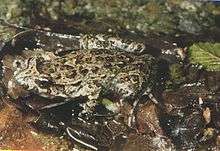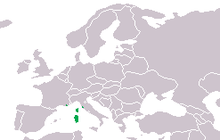Tyrrhenian painted frog
| Tyrrhenian painted frog | |
|---|---|
 | |
| Scientific classification | |
| Kingdom: | Animalia |
| Phylum: | Chordata |
| Class: | Amphibia |
| Order: | Anura |
| Family: | Alytidae |
| Genus: | Discoglossus |
| Species: | D. sardus |
| Binomial name | |
| Discoglossus sardus Tschudi, 1837 | |
 | |
The Tyrrhenian painted frog (Discoglossus sardus) is a species of frog in the Alytidae family (formerly Discoglossidae). It is found in Sardinia, Corsica and the Tuscan Archipelago.
Its natural habitats are temperate forests, rivers, intermittent rivers, freshwater marshes, and intermittent freshwater marshes. It is threatened by habitat loss.
Description
The Tyrrhenian painted frog is very similar in appearance to the Corsican painted frog (Discoglossus montalentii) but has a noticeably less rounded snout and a more rounded back. The fourth finger of its front foot is spatulate rather than tapering and its hind legs are shorter.[2] It grows to about 6.5 centimetres (2.6 in) long. The colour varies and is either plain brown, grey or reddish brown, or one of these colours with dark brown spots that do not have pale edges. The underside is pale.[3]
Distribution and habitat
The Tyrrhenian painted frog is found in most parts of the islands of Corsica and Sardinia but it is not present in the central highlands. It is also present on several small islands in the Tyrrhenian Sea such as Iles d'Hyères, Giglio, Montecristo, and the Monte Argentario peninsula in Tuscany. Its habitats include coastal plains, forest streams, maquis shrubland and upland coniferous forests. Slow streams and pools are used for breeding and this frog can tolerate brackish water.[1][3]
Biology
Like other members of its family, the Corsican painted frog eats small invertebrates. It is unclear whether observations of this frog in the past were of D. sardus or D. montalentii. This is because they are so similar in appearance and were only recognised as different species in the late 20th century. Consequently, its reproductive habits are uncertain but it is believed to lay its eggs in small groups or singly on the bottom of watercourses. They are brownish-black and 1 to 1.5 mm (0.04 to 0.06 in) in diameter with a thick, gelatinous casing.[3]
Status
The IUCN has listed this frog as being of "Least Concern". The populations in Corsica and Sardinia seem stable but mainland populations are decreasing and populations on smaller islands may suffer from lack of genetic diversity. The main threats faced by this frog are degradation of its woodland and aquatic habitats, however it seems adaptable and able to tolerate some disturbance to its habitat.[1]
| Wikimedia Commons has media related to Discoglossus sardus. |
References
- 1 2 3 Franco Andreone; Roberta Lecis; Claude Miaud; Claudia Corti; Roberto Sindaco; Antonio Romano (2008). "Discoglossus sardus". IUCN Red List of Threatened Species. Version 2013.1. International Union for Conservation of Nature. Retrieved 2013-12-08.
- ↑ Arie van der Meijden (2002-05-25). "Discoglossus montalentii". AmphibiaWeb. Retrieved 2013-12-08.
- 1 2 3 Arie van der Meijden (2002-05-25). "Discoglossus sardus". AmphibiaWeb. Retrieved 2013-12-08.
